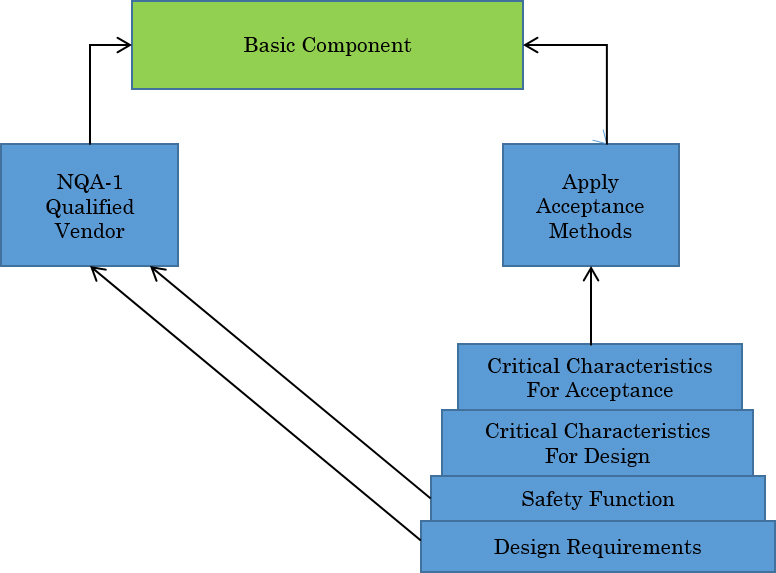What is Commercial Grade Dedication? (CGD)
Beginnings of Commercial Grade Dedication
As the nuclear industry contracted through the 1980s and 1990s many suppliers stopped maintaining the rigor of processes mandated by ASME-NQA-1. This sometimes prevented a purchaser from acquiring an item for nuclear service where the item’s ability to perform its safety function was not already established with reasonable assurance. It was the need to replace items being used in nuclear applications with those from unqualified suppliers (suppliers that could not meet the requirements of ASME-NQA-1) that drove the need to establish a consistent set of expectations in the commercial nuclear industry. This need has since grown to include new components and materials for use in nuclear applications as construction of new plants face the same issue.
The commercial grade dedication (CGD) process was first developed by the commercial nuclear industry and regulated by the Nuclear Regulatory Commission. The final push for the process occurred in the 1990s with the Electric Power Research Institute (EPRI) taking the lead for the commercial nuclear industry by publishing guidance to assist in establishing the ability of an item to perform its safety function with reasonable assurance. The EPRI guidance was published as EPRI- 5652, Guideline for the Utilization of commercial-grade Items in Nuclear SafetyRelated Applications (NCIG-07). This document is still relevant today and forms the basis upon which the ASME Nuclear Quality Assurance Committee drew in developing the requirements in ASME-NQA-1-2008 and NQA-1a-2009.
Introduction of Basic Components
The shift in how items were procured created a need for a definition of acceptability for nuclear service that encompassed both ways of procuring items. As a result of this, when an item has been shown to have adequate assurance that it will perform its safety functions on demand it is considered a “Basic Component.” A Basic Component is defined in ASME-NQA-1a-2009 as: “a structure, system or component, or part thereof that affects its safety function, that was designed and manufactured in accordance with the requirements of this Standard, or Commercial Grade Items which have successfully completed the dedication process.”
Thusly, when purchasing items for nuclear application, the most correct vernacular is no longer to obtain qualified parts (parts from a qualified supplier) but to obtain Basic Components. When procuring Basic Components the reasonable assurance that the item will satisfy its safety function is based upon a qualified supplier applying appropriate quality assurance requirements during the design and manufacture of the component, or by the successful completion of the commercial grade item dedication process.
This means that when an individual commercial item is properly dedicated and Basic Component status is achieved, it has the same nuclear pedigree as an item procured from a qualified supplier. This is shown in Figure 1, Pathways to Basic Component.
Figure 1, Pathways to Basic Component
Introduction of Basic Components
When the methodology for dedicating commercial grade items for nuclear applications was developed, the term commercial grade meant the item was produced in bulk and widely used (or at least available for wide use) in any number of applications. It assumed a certain history of performance that was generally acceptable to users.
You can see this assumption in the early definition for commercial grade items. The original definition for a commercial grade item, as presented in EPRI-5652, was that a Commercial Grade Item was: “an item:
- Not subject to design or specification requirements that are unique to nuclear facilities;
- Used in applications other than nuclear facilities;
- To be ordered from the manufacturer/supplier on the basis of specifications set forth in the manufacturer’s published product description (for example, a catalog).”
From the above it is easy to see that commercially available, off-the-shelf products with a wide distribution to many end-users were what the regulations and standards were aiming at. Another way of saying this is that the item was a standard catalog item.
Commercial Grade Dedication Today
In today’s business environment, locating a commercial supplier for many items is easier than ever. There are suppliers located world-wide for most items. These items are manufactured from a wide variety of materials for application in many industries. But what about when there is a need for a unique item for a specific process, one not commonly used anywhere else, is needed?
From the early 1970s through the late 1980s equipment for unique functions or applications could be obtained from several suppliers, all of whom had quality assurance programs meeting regulatory requirements. The quality assurance standards were not known as NQA-1 in those days. Today that is simply not the case. Many suppliers that had qualified quality assurance programs no longer maintain them due to the low nuclear product demand over the last 30 years. In applying the original definition of a commercial grade item you can see that a unique engineered item will not fit the definition. Today there are 3 definitions for a commercial grade item in NQA-1a-2009, Subpart 2.14.
NQA-1 was revised in 2008 with the goal of obtaining the endorsement of the Nuclear Regulatory Commission (NRC). After working through issues dealing with some of the content of NQA-1-2008, ASME issued an Addendum to NQA-1, NQA-1a-2009. The NRC endorsement of this standard is documented in Regulatory Guide 1.28, Quality Assurance Program Criteria (Design and Construction), Revision 4. This endorsement was issued in June 2010.
Have your engineering, procurement, and quality assurance organizations been trained on the new requirements, particularly with regard to engineered, one-of-a-kind items?
Commercial Grade Dedication Resources
Upcoming Classes
No classes are currently scheduled.




